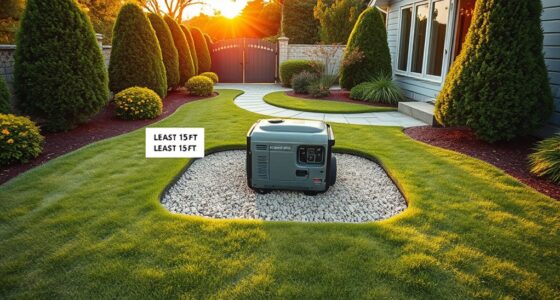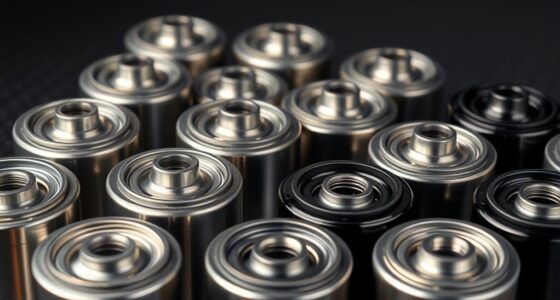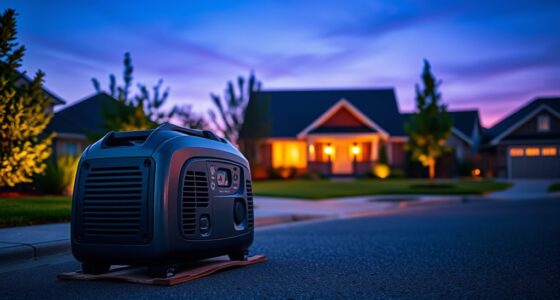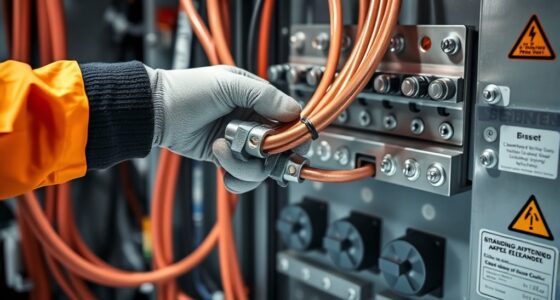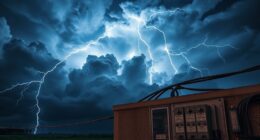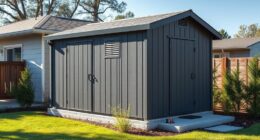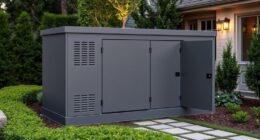When installing your generator, it’s crucial to follow proper setbacks to keep your home safe and guarantee efficient operation. Place it far enough away to prevent carbon monoxide buildup and reduce noise, but not so far that it becomes costly or hard to access. Check local codes and manufacturer guidelines to avoid fines or safety hazards. Keep clear of obstructions and consider ventilation and ground stability. If you want to avoid common mistakes, there’s more to learn on each step of the process.
Key Takeaways
- Proper generator placement ensures safety, efficiency, and compliance with local codes, reducing risks like carbon monoxide buildup.
- Follow manufacturer guidelines and local setbacks to maintain safe distances and prevent hazards or damage.
- Avoid placing the generator too close to your home to reduce noise, safety risks, and operational issues.
- Ensure adequate ventilation by removing barriers, increasing clearance, and possibly adding vents to prevent overheating.
- Seek professional help for complex site challenges and perform regular maintenance to keep the generator running safely and efficiently.
Why Proper Placement Matters for Your Generator
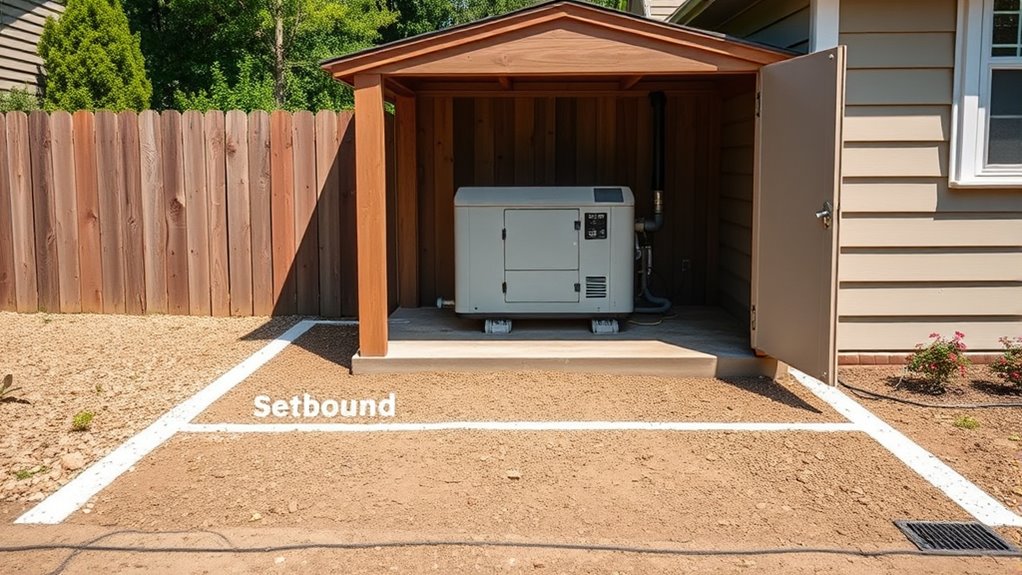
Proper placement of your generator is essential to guarantee safety, efficiency, and long-lasting performance. When you position your generator correctly, you optimize fuel efficiency, ensuring it uses fuel wisely and runs smoothly during power outages. Proper placement also minimizes the risk of dangerous fumes or carbon monoxide buildup, safeguarding your household. Additionally, strategic placement can reduce installation costs by avoiding the need for extensive wiring or modifications. If you place the generator too far from your home or in an unsuitable location, you may face increased costs and inefficiencies. Conversely, positioning it correctly from the start helps you avoid costly adjustments later. Overall, thoughtful placement maximizes your generator’s performance while keeping safety and costs in check. Considering environmental factors such as airflow and ventilation can further enhance its operation and safety.
Understanding Local Codes and Regulations
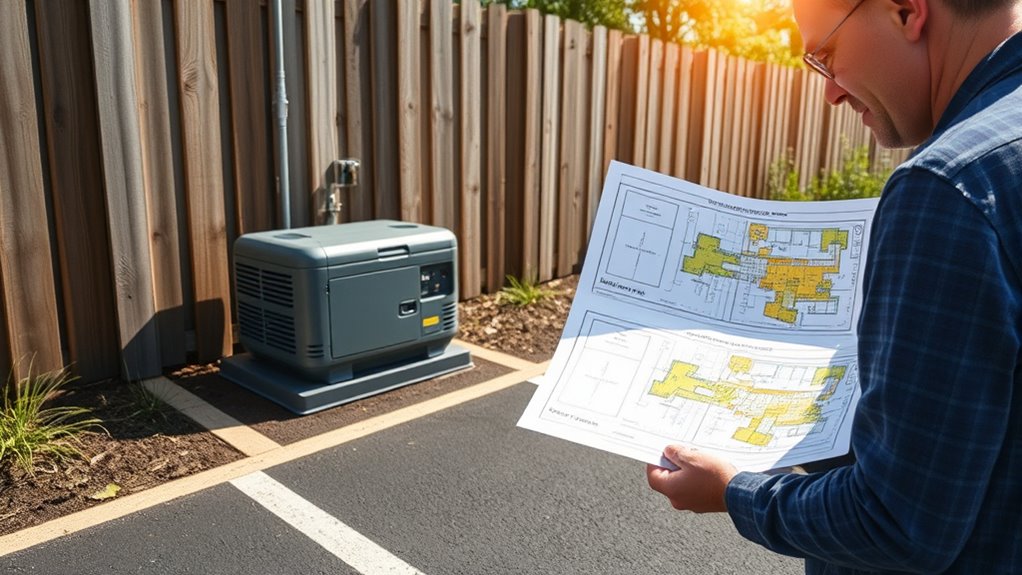
Before installing a generator, you need to understand the local codes and regulations that govern its placement and operation. Local building codes set specific requirements to guarantee safety and compliance, which can vary by area. Permit requirements are also essential, as many jurisdictions mandate permits before installation. Failing to adhere can lead to fines or the need for costly modifications. To stay compliant, consider these key points:
- Check for restrictions on generator size and noise levels
- Review setbacks mandated by local building codes
- Confirm if permits are required before installation
- Understand any special zoning rules affecting placement
How to Determine the Right Distance From Your Home
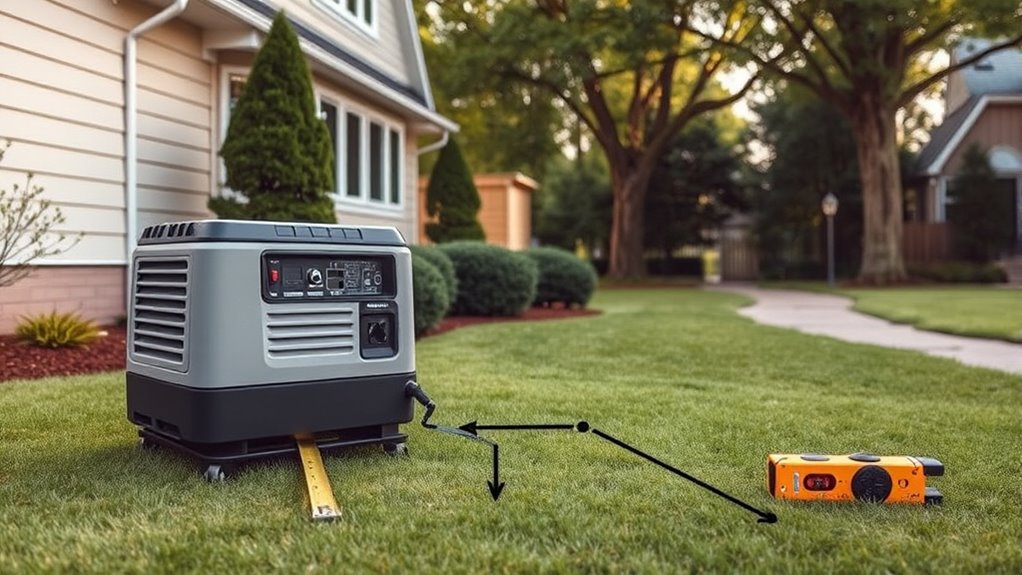
Determining the right distance for your generator from your home is essential to guarantee safety, minimize noise disturbance, and comply with local regulations. Placing it too close can increase noise and safety risks, while too far might lead to higher installation costs and reduced fuel efficiency. To find the ideal spot, consider the manufacturer’s recommended setbacks and local codes. A proper distance helps ensure safe exhaust venting and prevents carbon monoxide buildup. Keep in mind that increasing the distance may raise installation costs due to longer wiring or fuel line runs. Balancing safety, noise reduction, and cost efficiency is key. Measure carefully and consult local regulations to choose a spot that maximizes fuel efficiency without compromising safety or incurring unnecessary expenses. Inverter generator placement also plays a role in reducing noise and ensuring optimal performance.
Common Placement Mistakes and How to Avoid Them

One common mistake is placing the generator too close to the home, which can lead to dangerous carbon monoxide buildup and increased noise levels. To avoid this, guarantee proper setbacks that promote safety and compliance. Poor placement can also decrease fuel efficiency by forcing longer fuel lines or complicated routing, raising overall installation costs. Additionally, neglecting proper clearance can cause overheating or maintenance challenges. Properly positioned generators not only improve safety but also contribute to deterrence of criminal activity, as visible security measures can discourage theft or vandalism.
Checking Clearances and Obstructions Around the Generator
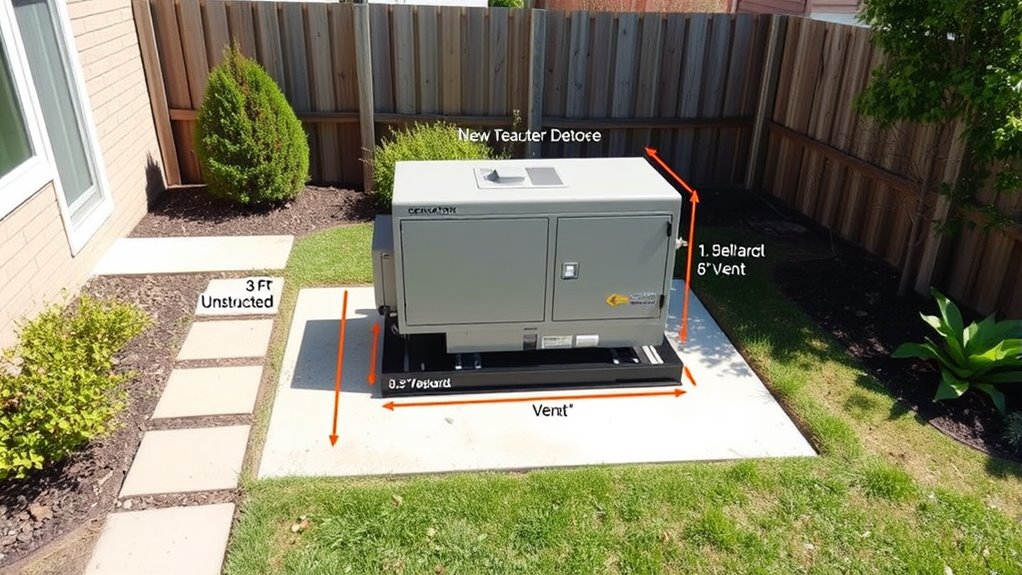
You need to guarantee there’s enough clearance around your generator for safe operation and maintenance. Start by reviewing the specific clearance requirements in your local codes and manufacturer’s guidelines. Then, identify any obstructions nearby and keep safe distances clear to prevent hazards and ensure proper ventilation. Additionally, consider the projector technology used in your setup, as different types may have varying space and ventilation needs to optimize performance.
Clearance Requirements Overview
Making certain proper clearance around your generator is essential for safe operation and maintenance. Adequate space prevents obstructions that could hinder airflow, which affects fuel efficiency and overall performance. It also facilitates safe access for inspections, fueling, and servicing. To meet clearance requirements, consider these key points:
- Maintain recommended setbacks from walls, structures, and vegetation
- Keep a clear path for ventilation and exhaust fumes
- Avoid placing objects that could obstruct airflow or cause fire hazards
- Ensure easy access for emergency shutdowns and routine maintenance
- Incorporate awareness of fire safety considerations to reduce the risk of hazards around the generator.
Identifying Obstructions Effectively
To effectively identify obstructions around your generator, start by visually inspecting the entire clearance area, paying close attention to objects that could block airflow or access points. Look for landscape obstacles like shrubs, trees, or rocks, as well as nearby structures such as fences or walls that might hinder ventilation or maintenance. Additionally, it’s important to consider self watering plant pots that could be placed too close to the generator, potentially affecting the clearance and airflow.
| Obstruction Type | Potential Impact |
|---|---|
| Landscape obstacles | Block airflow, cause overheating |
| Nearby structures | Restrict access, create hazards |
| Debris | Clog vents, increase fire risk |
| Overgrown vegetation | Limit clearance, restrict movement |
Keeping the area clear ensures proper ventilation and safe access, reducing the risk of operational issues or accidents. Regular inspections help you maintain unobstructed clearance and avoid potential problems.
Maintaining Safe Distances
Maintaining safe distances around your generator is essential for ideal performance and safety. Proper clearances prevent obstructions that could hinder fuel efficiency and complicate maintenance schedules. Ensure there’s enough space for ventilation, avoiding objects or structures that could block airflow. Regularly check for debris, overgrown vegetation, or nearby structures that might pose hazards or restrict access. These precautions help keep your generator running smoothly, reduce the risk of damage, and facilitate routine inspections. Remember, a well-maintained space contributes to efficient operation and longevity. To optimize safety and performance, keep clearances consistent with manufacturer guidelines and revisit your setup periodically. Staying proactive with these measures ensures your generator stays reliable and safe during emergencies. Additionally, clear space around the generator helps prevent fire hazards and allows for easier troubleshooting or repairs when needed.
Troubleshooting Noise and Ventilation Issues
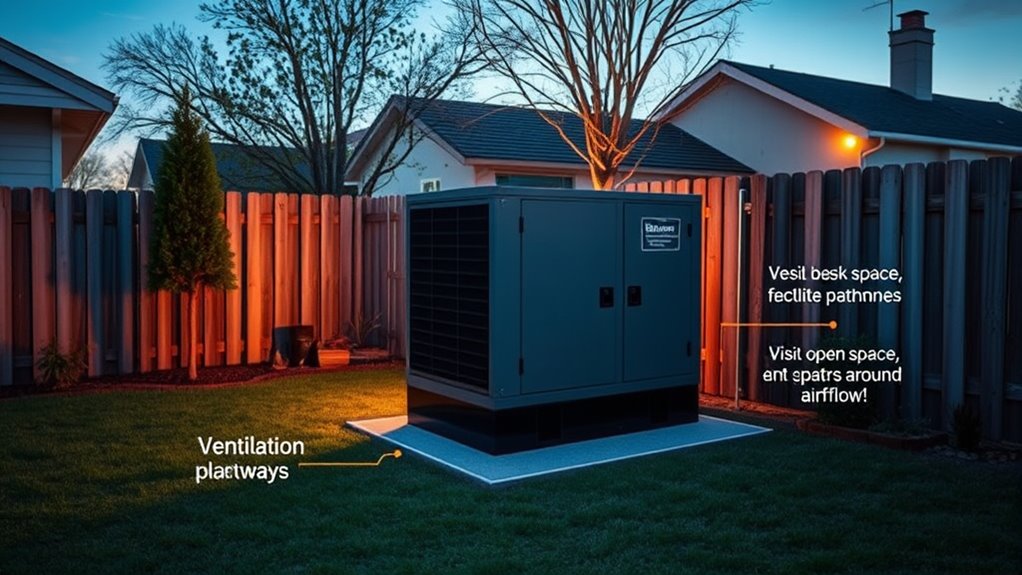
If your generator is making too much noise or isn’t ventilating properly, it’s time to investigate. You can manage excessive sound levels by adding sound barriers or relocating the unit, and improve airflow by adjusting its placement. Addressing these issues can make your generator run more quietly and efficiently. Additionally, ensuring proper ventilation can help prevent overheating and maintain optimal performance.
Managing Excessive Noise
Excessive noise from a generator can disrupt your peace and indicate underlying ventilation issues. To manage this, consider implementing effective noise reduction techniques. Soundproofing barriers, like dense fences or acoustic panels, can considerably dampen sound transmission. You might also locate the generator farther away from living spaces to minimize disturbance. Regular maintenance ensures the engine runs smoothly, reducing excessive noise caused by mechanical issues. Additionally, enclosures designed with soundproofing materials can contain noise more effectively. Proper planning and installation are key to balancing sound management with safe generator operation. Utilizing noise-reducing materials can further enhance soundproofing efforts and create a quieter environment while addressing ventilation concerns.
Improving Ventilation Flow
Improving ventilation flow is essential when addressing noise and ventilation issues caused by generator operation. To enhance airflow optimization, start by removing any ventilation barriers that restrict air movement around your generator. Ensure there’s enough clearance on all sides to allow proper air intake and exhaust. Check for obstructions like debris, fences, or plants that could block airflow. If ventilation is still inadequate, consider installing additional vents or exhaust outlets to improve circulation. Proper ventilation not only reduces noise levels but also prevents overheating and improves overall efficiency. Remember, consistent airflow is key to maintaining a safe and quiet environment. By eliminating barriers and optimizing airflow, you’ll notably reduce noise issues and ensure your generator operates smoothly. Additionally, consider the Vetted Electric Bike Conversion Kits, which are designed for reliable performance and efficient operation, highlighting the importance of proper setup and airflow.
Dealing With Wet or Unstable Ground Conditions

Wet or unstable ground conditions can pose significant challenges when placing your generator, as they increase the risk of shifting, sinking, or creating hazards. To guarantee safety and stability, you need to focus on ground stabilization and moisture control. Properly evaluating the site helps determine if additional measures are necessary. You might consider adding gravel or compacted soil to improve support. Using concrete pads can provide a firm, level base resistant to shifting. Elevating the generator on a sturdy platform prevents contact with excess moisture, reducing corrosion risks. Additionally, draining excess water away from the site minimizes ongoing moisture issues. Prioritizing these steps helps ensure your generator remains secure and functional, even in adverse conditions.
When to Seek Professional Help for Placement and Setbacks
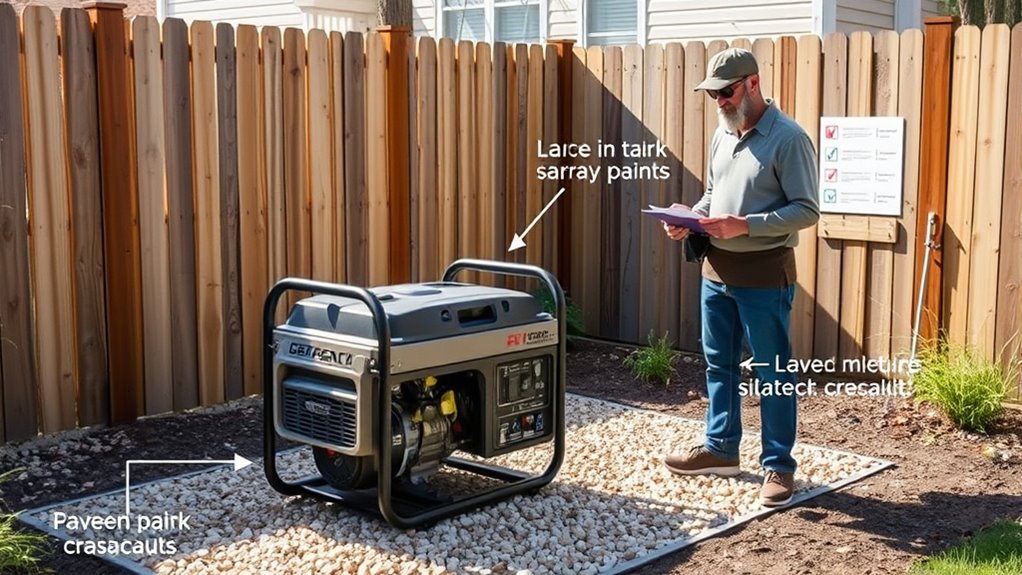
While some generator placement issues can be addressed on your own, there are times when professional help becomes vital. If you’re unsure about proper setbacks or encounter complex obstacles, a professional evaluation guarantees safety and compliance. A licensed expert can evaluate your site, identify hazards, and perform a thorough safety inspection to prevent future problems. Recognizing signs like persistent ground instability or restrictive space is essential.
| When to Seek Help | Why It Matters |
|---|---|
| Uncertain about setbacks | Avoid safety risks and code violations |
| Difficulty assessing ground | Prevent costly mistakes |
| Obstructions or hazards | Ensure safe operation |
| Conflicting regulations | Maintain legal compliance |
Frequently Asked Questions
Can I Install a Generator Indoors Safely?
You shouldn’t install a generator indoors because it’s unsafe. Indoor safety is a major concern, as generators produce dangerous carbon monoxide that can build up quickly. Proper ventilation requirements are essential; if you must have a generator nearby, place it outdoors in a well-ventilated area, away from windows and doors. Always follow manufacturer guidelines and local codes to prevent harmful fumes and guarantee safe operation.
How Do Weather Conditions Affect Generator Placement?
Weather conditions considerably impact your generator placement. Wind impact can cause instability or blow debris into the unit, so place it where wind is minimized. Temperature effects also matter; extreme cold can hinder operation, while excessive heat may cause overheating. To guarantee reliable performance, choose a sheltered, dry spot that offers good airflow, and avoid areas prone to flooding or heavy wind exposure. Proper placement helps your generator run smoothly in any weather.
Are There Specific Setbacks for Portable vs. Standby Generators?
Yes, there are specific setbacks for portable and standby generators. Portable units should be placed at least 20 feet away from windows, doors, and vents to reduce generator noise and emissions concerns. Standby generators, being larger, need even greater distances—often 5 to 10 feet further—to minimize noise disturbance and prevent exhaust fumes from entering your home. Always check local codes for exact setback requirements to guarantee safety and compliance.
What Are the Consequences of Ignoring Setback Regulations?
Ignoring setback regulations jeopardizes generator safety and leads to setback violations, risking damage to your property, personal injury, and potential legal penalties. You expose yourself to carbon monoxide poisoning, fire hazards, and electrical malfunctions. By neglecting these rules, you compromise safety and invite costly repairs or fines. Always respect setback guidelines to protect yourself, your loved ones, and your investment, ensuring your generator operates safely and effectively.
How Often Should I Check Clearance and Ventilation Around My Generator?
You should check clearance and ventilation around your generator at least once a month. Regularly inspecting these areas guarantees proper airflow, which improves fuel efficiency and reduces noise levels. Keep the space clear of debris and obstructions, and verify that vents are unobstructed. Proper ventilation not only enhances performance but also minimizes safety risks. Staying proactive helps your generator run smoothly, efficiently, and quietly over time.
Conclusion
Proper generator placement isn’t just about following rules—it’s about safety, efficiency, and peace of mind. By understanding setbacks, local codes, and common mistakes, you can avoid future headaches. Are you ready to guarantee your generator is positioned for optimal performance and safety? Taking the time now to plan your setup can save you trouble later. Don’t wait until it’s too late—make smart placement choices today for a reliable, hassle-free backup power solution.


